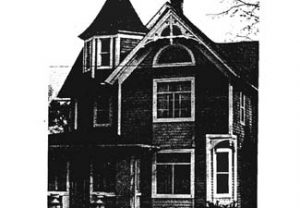Downtown Richmond devastated the night before Christmas 1902
By Gregory Harutunian For Chronicle Media — December 24, 2019
The Schroeder house in 1902 was the scene of Ralph “Darb” Kilburn’s effort to save the structure, standing on the roof’s pinnacle, throwing water onto horse blankets. (Photo by Gregory Harutunian/for Chronicle Media)
The Village of Richmond has come to be known as “The Village of Yesteryear,” for the quaint appearance of its historic downtown business district, bordered roughly by Main, Mill, and Broadway streets. Walking the area one notes the date mantles on commercial building tops displaying dates from 1903-14, with outlying residential homes reflecting the “Italianate or Second Empire styles,” according to Gail Drabant’s “History of the Covell House.”
A cryptic paragraph from her writing states, “On Christmas Eve 1902, a devastating fire swept through most of Richmond’s commercial district destroying twenty buildings. The fire was a setback for Richmond’s economic growth as most of the buildings were either uninsured or underinsured. Many business owners did not bother to rebuild at all, following the fire.”
The McHenry County Historical Society has no photographs of the devastation caused in the town that night. An email from its administrator, Kurt Begalka, stated he had located the 1832-98 McHenry County history book describing the fire as: “Richmond’s worst. At 1:00 a.m., those living in the ‘flats’ near Main and Broadway streets smelled burning wood … apparently from the rear of the bakery. The fire raged through the Richmond Gazette’s printing plant, and another 20 downtown buildings.”
The story was recorded in the Jan. 1, 1903 edition now-defunct Richmond Gazette, and reprinted in 1961. While the society has acquired the Richmond Gazette holdings, the 1961 information came from a photocopy supplied by the late mother of Richmond USPO work, Kris Anderson.
“I lived in the T.C. Schroeder house, the home on the south side of the Richmond Memorial Hall, as a little girl,” said Anderson. “My mother told me the story of the fire. She said there was a horse and tack shed in the back.”
The Schroeder house, and the efforts to save it from the fire, played a large part in the entire town not going up in flames.
The Richmond Gazette’s article said people living in the apartment flats were “aroused by the smell of burning wood. Upon investigation, fire was found to be raging in the rear of the building, occupied by A. Fisher, in a bakery-restaurant, and the partition between the kitchen and William Nyquist’s drug store.” Considered too far gone to save, the city marshal was notified and the lone fire engine was brought into action.
Fire consumed the jewelry store and meat market on either side of the structure, working its way to the Rice Bakery and Restaurant heading south. The adjoining Velsey Tailor Shop was soon engulfed by flames, and helped the blaze wind around the corner catching a millinery shop which also soon caught fire. A bucket brigade was formed, chain-carrying containers of water that were hand-thrown onto the fire. The conflagration halted at the walls of the old bank building on Broadway Street.
Unfortunately, the heat set other buildings into flame on the east side of the street consuming the “Nash Grocery Store, Wray’s Undertaking and Furniture Establishment, along with the Gazette’s own printing and news offices. Johnott’s Grocery in the former 1905 Emporium building, and the city jail” also burned to the ground.

The State Bank of Richmond, built in 1890, marks the point where the great fire of Christmas Eve 1902 stopped and changed direction to head east toward other commercial and residential dwellings. (Photo by Gregory Harutunian/for Chronicle Media)
Saving the nearby Schroeder house was “scene of a valiant and successful attempt by Ralph ‘Darb’ Kilburn to arrest a raging fire … Kilburn sat on the topmost pinnacle throwing buckets of water on horse blankets covering the roof until the blaze subsided.” The gazette article also said Kilburn’s clothing would ignite from the heat, and were “summarily extinguished by dashes of icy water.”
The paper’s account continued, “Kilburn’s efforts to save the Schroeder house became a focal point since it was presumed that had the walls started to burn, it could have taken the entire southeast portion of the town with it.” Kilburn was a “center of attraction,” standing on the roof’s pinnacle, and before long, many others joined to protect the house and quash the flames.
No one was seriously hurt, the next day brought a survey of the ruined structures. It was estimated that damages amounted to approximately $40,000 in 1902 currency rates, and translates to $1.2 million in 2019. The ruined structures were uninsured and left no funds for rebuilding. A subsequent investigation determined the cause of the fire was “considered that a defective flue in the restaurant” and a coffee pot on the stove.
The historic downtown business district as it appears today, while appearing quaint, is shaped by what transpired on Christmas Eve 1902, in rising from the ashes.
One interesting footnote: the original fire engine owned by the city and deployed that evening was found, decades later. The Richmond Township Fire Protection District purchased and restored the apparatus. It is now on display at their stationhouse, located at Route 12 and Hunter Drive in Richmond.








